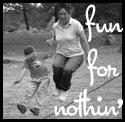It is interesting to me that while we haven't been officially "Homeschooling" since October 2011, I am still approached by people with queries on the how's and why's of it. I still consider myself a "homeschooler", and as such remain an advocate for the modality. Recently, I dug up this bit of information I compiled in 2009 to help educate the Rock Springs Wyoming Police Department. (I also found all of these photos archived in our 2011 Homeschool Year Adventures.)
One
of the best things about homeschooling is the fact that there are different
approaches available. No two children are exactly the same. Each child has a
different learning style and each family has different routines and needs. Many
educational methods lack the ability to adapt to the unique needs of the
individual, but homeschooling is different. A homeschool approach can be
whatever best fits for the particular student and family.
Although
every homeschool is unique, certain homeschooling "styles" have
become very popular. Most homeschoolers do not follow one style or method
exactly. Instead, they select the ideas and suggestions that fit their family
and eventually end up with a method all their own. The following are the most popular
homeschooling styles.
- School-at-Home - This homeschool approach is very similar to education in a traditional
school setting. Homeschool parents who choose this method typically use
standardized textbooks and curricula to teach their children. Homeschool parents
who use this method often create traditional lesson plans and adhere to
homeschooling schedules. Other homeschool parents choose to purchase lesson
plans. Some who use this homeschool approach set up separate schoolrooms,
complete with desks for both the homeschool children and the parent teacher.
However, this is not always the case as homeschooling lends itself to just
about any location.
- Unit Studies - Available free or for sale to homeschoolers. Also how to make your own.
- "Relaxed" or "Eclectic" Homeschooling - Some like to pick and choose
among various methods, enjoying the flexibility it affords.
- Unschooling - Natural learning is letting your child lead the way.
- Classical Homeschooling - Many Christian and other families prefer a liberal
arts education for their children, including lessons in Greek and Latin, as
well as formal instruction in logic.
- The Charlotte Mason Method - This approach advocates reading good books from
original sources and spending lots of time in nature.
- The Waldorf Method - Developed by Rudolf Steiner, this method emphasizes
arts and crafts, music and movement. Students learn to read and write by making
their own books.
- Montessori - Maria Montessori advocates observing your child, removing obstacles to
learning and providing children with real, scaled-to-size tools to use.
- Multiple Intelligences
- Distance Learning - Companies and schools that provide teaching assistance as well as
learning materials. These schools vary widely in their choice of method, let
alone formality.
- Enki Education Method - Enki is it's own wonderful thing. Besides drawing
from the best of Waldorf, Enki also draws from Montessori, the United Nations
International School, Theme Studies and even the discovery learning of John
Holt.
- Resource Centers & Cottage Schools - Mini-schools are springing up
among homeschoolers all over the world.
- Studio Teachers - Young entertainers and athletes often need especially accomodating
tutors, willing to travel with them.
- Tutoring - Hiring a tutor makes a family (and the tutor) fall under the tutoring
laws of a state's education code, rather than under homeschooling laws,
especially if they intend to hire a tutor full time.
- Umbrella Schools - Independent Study Programs, Distance Learning Programs, Virtual or
Cyber (Internet) Schools, Charter Schools, Learning Centers, DVD/Video
Schooling.
- EarthSchooling - The new generation of ecletic schoolers considers the entire EARTH
their school. We don't stay at HOME! Some travel the USA or the WORLD or have a
classroom OUTDOORS. We may "homeschool" part-time or full-time or we
may be involved in after-school or weekend enrichment activities. What we all
have in common is that we base our schooling on the needs of our family & we create our own "ideal school"
from the many varied resources available.

There
is no typical homeschooled child or homeschooling experience. There is no
recipe. Parents say it is all about 'customizing' learning for their kids.
Some homeschooled kids participate in selected public–school classes and activities. There are parents who replicate the regular school day with class periods and packaged alternative curricula. Other parents encourage their children to pursue their current interests and avocations (creating complex Lego villages, modeling clay, writing plays, learning about Native American architecture) as avidly as possible, believing self-directed learning to be the most joyful and rewarding. Immersion in the natural world and volunteerism were mainstays of other homeschooling environments.
This data was compiled from these websites:
Other Helpful refrences:
The Homeschooling
Book of Answers
by Linda Dobson. Almost four dozen homeschooling experts answer just about
every question on homeschooling how-to's. After nine years of homeschooling, I
still refer to this book.
Homeschooling: The
Early Years: Your Complete Guide to Successfully Homeschooling the 3- to
8-Year-Old Child
by Linda Dobson. The best resource for providing answers to the unique
challenges (and opportunities) of teaching the very young child at home.
Homeschool Your Child
for Free
by LauraMaery Gold and Joan M. Zielinski offers more than 1,200 resources for
home education on the Internet and beyond. Reassuring advice and stories
accompany links to amazing educational sites. The most used homeschooling book
in my library!
Homeschooling: The
Teen Years: Your Complete Guide to Successfully Homeschooling the 13- to
18-Year-Old
by Cafi Cohen. As the cover states, "If you're homechooling a teenager
you'll want -- and need -- this outstanding book." Cohen makes
homeschooling a teen fun. (Well, almost!)
How to Get
Your Child off the Refrigerator and On to Learning by Carol Barnier.
This book may be the single biggest aide I found in allowing my sons’ to
learn in a way best suited to their natures.
It helped me understand that “a math lesson shouldn’t be confused with a
writing lesson.” It really is okay to teach
them while they are in motion, instead of forcing them to sit still and be
quiet!























